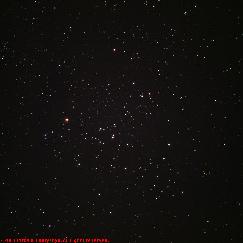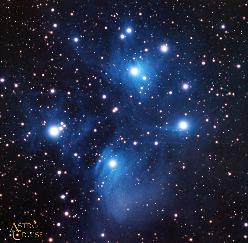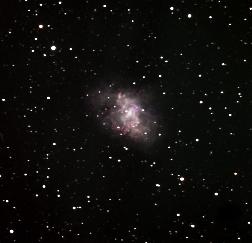Taurus
Hyades - Open Cluster
Pleiades - Open Cluster
M1: Crab Nebula - Supernova Remnant
Taurus is highest in the sky during December and January, but easily visible in neighbouring months for those in the northern hemisphere. It forms part of a spectacular skyscape along with Orion, Canis Major and Gemini. Taurus contains three A-List objects; the two closest open clusters to us in the heavens and also a supernova remnant.
Hyades Open Cluster E B L
This famous V-shaped cluster outlines the head of Taurus, the Bull, with the bright star Aldebaran as his eye. In fact, Aldebaran is not part of the cluster and lies at only half of its 150 light-year distance. Stars can be shown to be part of a cluster by measuring their 'proper motion' - the path they take across the sky. All the stars of the Hyades are moving along parallel paths eastwards towards a point close to Betelgeuse in Orion. In contrast, Aldebaran is moving southwards. The cluster has a central core about 10 light years in diameter with outer members spread over a volume some 80 light years across. It is thought to be about 730 million years old. Its angular extent is over five degrees across so is best seen with binoculars, but a telescope at low power can give a nice view of its core including a prominent double star.
Position: 04h 26.9m +15deg 52min
M45 - The Pleiades Cluster Open Cluster E B L
Perhaps the most beautiful open cluster in the heavens, it is often called the Seven Sisters. This name comes from a mythological story in which seven sisters were placed in the heavens to overcome their grief over the death of their father. Interestingly, almost no-one would ever see precisely seven stars. Most people actually see six stars with their unaided eye under dark skies. There is a significant drop in brightness between the sixth brightest star and the next four which still lie above the nominal unaided eye limit of 6th magnitude. So those that see more than six are likely to see nine or 10. Amazingly, under superb conditions with well dark-adapted eyes some have managed to discern up to 30! The cluster is about two degrees across and binoculars or a short focal length telescope at low power can encompass the whole of the cluster- one of the best sights in the sky. Particularly pretty is a little triangle of stars just besides Alcyone, the brightest star in the cluster, and a double star appearing almost in the centre of the cluster. The Pleaides cluster is very young, only 70-100 million years old, and contains about 100 stars. It is just 380 light years away from us, so is a relatively close neighbour in space. Colour photographs show that the brighter stars of the cluster are surrounded by blue reflection nebulae. These are caused by starlight reflecting off dust grains in the space between the stars and so, not surprisingly, is most apparent close to the three brightest stars. If the sky is very transparent and dark, this nebulosity can be observed, but almost in reverse: the background sky at the very centre of the 'square' formed by the four brightest stars of the cluster appears distinctly darker than that close to the stars themselves.
Position: 03h 47.0m +24deg 07min
M1 - The Crab Nebula Supernova Remnant B L M
This is one of two supernova remnants in the A-List (the other being the Veil Nebula in Cygnus) and is one of around 100 such objects known of in our galaxy. The progenitor star was seen to explode in AD1054 and is recorded in Chinese texts. There are no European records perhaps because, in the eyes of the church, the heavens were meant to be perfect and unchanging so the scribes, who were generally monks, could well have been reluctant to chronicle such events. Since the explosion, the gas that was ejected as the star exploded has been expanding out into space and is gradually getting fainter. The fact that it still glows in the visual part of the spectrum at all is due to a powerhouse at its centre - the Crab Pulsar. The core of the massive progenitor star collapsed down until it was no bigger than the size of a big city - but still weighing more that our Sun - and began to spin rapidly. Energy is radiated away from the region of space above its magnetic poles and it acts like an interstellar light house; two beams of light and radio waves sweeping around the sky 30 times a second. Some of the energy radiated away is keeping the nebula glowing. The nebula is a 6 by 4 minute of arc parch of nebulosity just one degree northwest of the 3rd magnitude star Zeta Tauri. Binoculars or a telescope at low power can thus show both in the same field so, given dark skies, M1 easy to find with 8x40 or 10x50 binoculars. Higher magnification using a telescope may make it somewhat easier to see. The pulsar is one of two stars at the centre of the nebula, both about 16th magnitude. Given a 10-inch (250mm) telescope and a superb, dark sky, observing site with excellent seeing conditions it can even be observed - the most exotic object anyone could ever expect to see. Its name, the Crab Nebula, was given to it by the sixth Earl of Rosse who observed it with a 72 inch reflector, then the biggest telescope in the world, from Birr Castle in Ireland. In his drawing it appears somewhat like a horseshoe crab (some would say pineapple), hence the name.
Position: 05h 34.5m +22deg 01min






